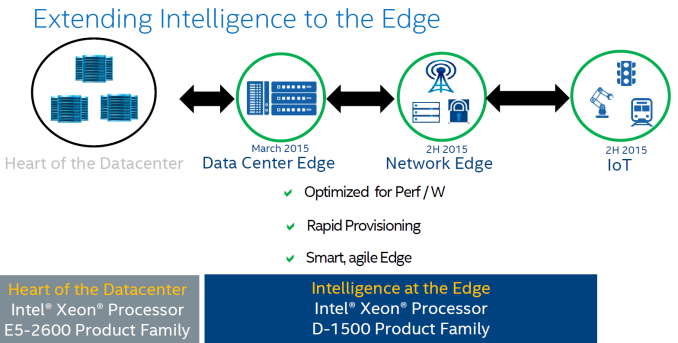The Intel Xeon D Review: Performance Per Watt Server SoC Champion?
by Johan De Gelas on June 23, 2015 8:35 AM EST- Posted in
- CPUs
- Intel
- Xeon-D
- Broadwell-DE
Conclusion: the Xeon D-1540 is awesome
If you only look at the integer performance of a single Broadwell core, the improvement over the Haswell based core is close to boring. But the fact that Intel was able to combine 8 of them together with dual 10 Gbit, 4 USB 3.0 controllers, 6 SATA 3 controller and quite a bit more inside a SoC that needs less than 45 W makes it an amazing product. In fact we have not seen such massive improvements from one Intel generation to another since the launch of the Xeon 5500. The performance per watt of a Xeon D-1540 is 50% better than the Haswell based E3 (Xeon E3-1230L).
Most of the design wins of the Xeon D are network and storage devices and, to a lesser degree, micro servers. Intel also positions the Xeon D machines at the Datacenter/Network edge, even as an IOT gateway.
Now, granted, market positioning slides are all about short powerful messages and leave little room for nuance. But since we have room for lengthier commentaries, our job is to talk about nuances. So we feel the Xeon D can do a lot more. It can be a mid range java server, text search engine or high-end development machine. In can be a node inside a web server cluster that takes heavy traffic.
In fact the Xeon D-1540 ($581) makes the low end of the Xeon E5 SKUs such as the E5-2630 (6 cores at 2.3 GHz, 95 W, $612) look pretty bad for a lot of workloads. Why would you pay more for such E5 server that consumes a lot more? The answer is some HPC applications, as our results show. The only advantage such a low end dual socket E5 server has is memory capacity and the fact that you can use two of them (up to 12 cores).
So as long as you do not make the mistake to use it for memory intensive HPC applications (note most HPC apps are memory intensive) and 8 cores is enough for you, the Xeon D is probably the most awesome product Intel has delivered in years, even if it is slightly hidden away from the mainstream.
Where does this leave the ARM server plans?
The Xeon D effectively puts a big almost unbreakable lock on some parts of the server market in the short and mid term (as Intel will undoubtably further improve the Xeon D line). It is hard to see how anyone can offer an server SoC in the short term that can beat the sky high performance per watt ratio when performing dynamic web serving for example.
However, the pricing and power envelope (about 60W in total for a "micro" server) of the Xeon D still leaves quite a bit of room in markets where density and pricing is everything. You do not need Xeon D power to run a caching or static web server as an Atom C2000-level of performance and a lot of DRAM slots will do. There are some chances here, but we would really like to see some real products instead of yet another slide deck with great promises. Frankly we don't think that the standard ARM designs will do. The A57 is probably not strong enough for the "non-micro server" market and it remains to be seen if the A72 will a large enough improvement. More specialized designs such as Cavium Thunder-X, Qualcomms Kryo or Broadcomm Vulcan might still capture a niche market in the foreseeable future.











90 Comments
View All Comments
julianb - Saturday, October 31, 2015 - link
Thanks for the reply, man.And sorry for my late reply, totally forgot about this thread :)
eva2000 - Tuesday, June 23, 2015 - link
Nice... Xeon D-1540 is awesome, but I wish it was clocked 0.2Ghz higher across the board would be just enough to tip that scale versus E5. Did my own benchmarks at https://community.centminmod.com/threads/2864/ :)extide - Wednesday, June 24, 2015 - link
Thats probably exactly why it ISNT clocked 0.2Ghz higher across the board ;)I'm sure Intel wants to see some space between this and E5.
boogerlad - Tuesday, June 23, 2015 - link
If this was marketed for the consumer market with the ability to overclock, this would outsell everything completely. This is what the enthusiast needs!!!Refuge - Tuesday, June 23, 2015 - link
I don't think this is going to do much of anything for an enthusiast.Unless they are interested in building a server for some experiment or project.
JohanAnandtech - Wednesday, June 24, 2015 - link
I still think the i7 59xx series is a better match for consumers: higher clocks and thus ST performance. The Xeon D most interesting features such as integrated 10 GBe and low power don't interest most performance consumers. Most people will have a hard time saturating a 1 GBe line and power savings are not a priority.tspacie - Wednesday, June 24, 2015 - link
Seems to tick all the boxes for a software development machine. Very good at compilation. Reasonably priced for the performance. Low power. ECC memory. I'm temptedextide - Wednesday, June 24, 2015 - link
EXACTLY what I was thinking!MrSpadge - Saturday, June 27, 2015 - link
I would be very tempted by such a chip as well, using it for BOINC. However, Broadwell looses some of the power efficiency advantage if you push it harder, i.e. the largest gains are at low and moderate frequency. Perfect for such server chips and mobile ones, but not so much for people aiming for 4+ GHz.MaxKreimerman - Tuesday, June 23, 2015 - link
Sounds impresive in just 45w package, but imposible to find in the retail sites such as newegg or wiredzone